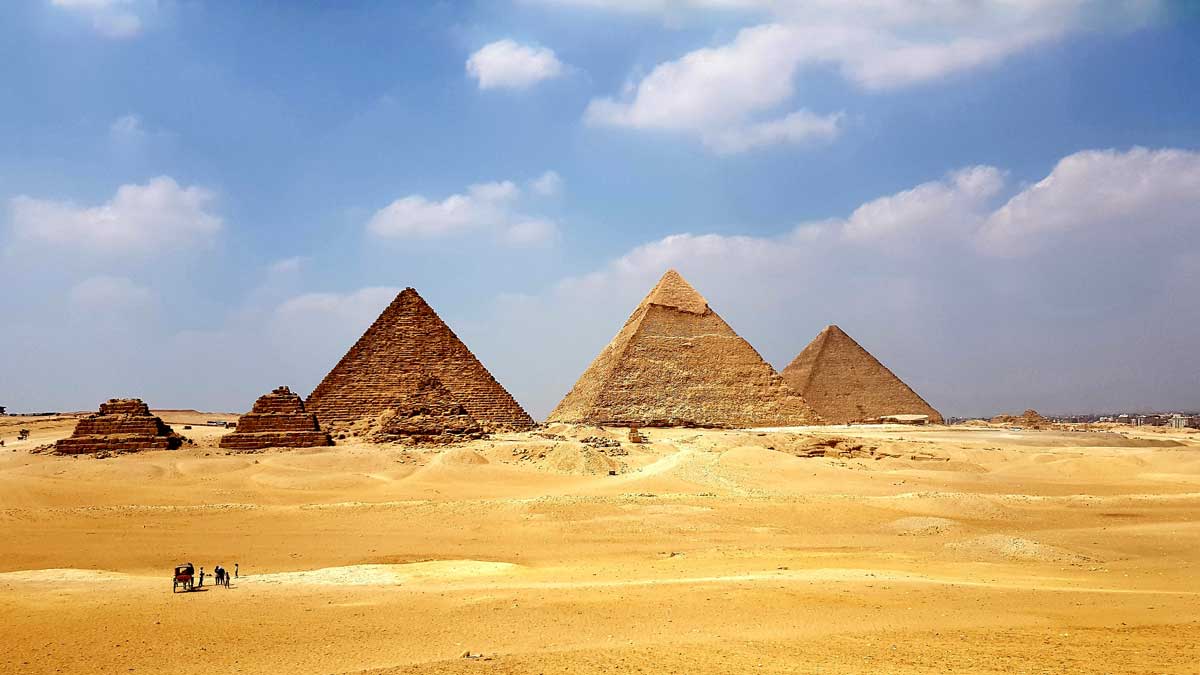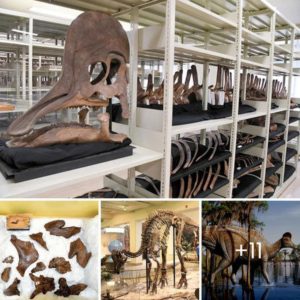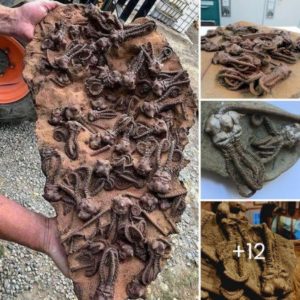Pyramids can be found on both sides of the Atlantic. But were they built by descendants of the city of Atlantis?
Pyramids. When one hears that term, there are a few images that likely come to mind. Perhaps the pyramids of Giza set in the sands of Egypt or the Mayan pyramids hidden in the jungles of Mesoamerica. These massive structures arguably form some of the most iconic images of archaeological sites. Not only are these fascinating structures to archaeologists and historians, but also to the general public most of whom would like to know: who made them and how were they made?

However, there are a group of people who see these structures and begin with a different question: why are there pyramids in different parts of the world? It is a question that more or less skips over the who and how, but nevertheless has been around for nearly a hundred years. To answer this question, a modern age mythology surrounding the pyramids of the world and their origin has evolved, which, in general, involves an ancient civilization from a continent known as Atlantis.
A Modern Mythology: Did Atlanteans Build the Pyramids?

Since there is no codified version of mythology, the story can only be summarized. Generally, the mythology goes that around 11,500 years ago the continent of Atlantis was populated by an advanced civilization. The Greek philosopher Plato, in his works Timaeus and Critias, claimed that Atlantis lay beyond the “pillars of Hercules” (which some believe were the modern-day straits of Gibraltar) as a great island in the sea. The island was described as being greater in size than Libya and Asia together and was powerful enough to attack Europe and Asia. At one point in the distant past, the civilization was wiped out by a great earthquake that turned the sea into an impassable muddy bank. From this collapsed civilization it is believed that the survivors traveled across the globe where they resettled and lived. From these remnants of Atlantis arose the pyramids that are found across the globe and their similarities in architecture can be explained by the cultures sharing a common origin in Atlantis.
Such a hypothesis is based on the cultural transmission of ideas through diffusion, a concept not unheard of in modern history. During the height of colonialism at the end of the 19th century, Westerners brought with them ideas regarding architecture, administration, farming, and so on. The construction of houses or administration centers in European styles for Westerners act as physical evidence of their presence in the region. While architectural buildings would not be exact replicas of what could be found in Europe, the buildings nevertheless reflect the origin of the European power building it (or rather having it built for them). Many of the Europeans that had colonies across Africa, Asia, and the South Seas, like the Belgians, French, British, Germans, and Americans, left behind buildings that resemble European architecture.
The Beginnings of the Theory
The idea that pyramidal structures were similarly made by Atlanteans was pondered in the 19th century by Ignatius L. Donnelly. He was an American congressman, but also viewed himself as a scientist. In 1882 he wrote Atlantis: The Antediluvian World which proposed that the catastrophic event that ended Atlantis was none other than the Great Flood found in the Bible. Donnelly proposed that the events described by Plato were factual and that humankind first became civilized at Atlantis. He also drew upon the similarities between the Phoenician alphabet, Mayan, and Egyptian hieroglyphs to show that these stemmed from an original Atlantean alphabet.
In chapter V he takes up the idea that the pyramids found on both sides of the Atlantic were the result of Atlanteans. Using archaeological knowledge from the time, he describes the structures of the Mayan, Aztec and Egyptian pyramids and even proposes that the artificial earth mounds found in the United States and England are connected. At the end of the chapter, he concludes by asking the reader, “Is it possible to suppose all these extraordinary coincidences to be the result of an accident?” He answers this by stating that it would be similar to assuming the American and English forms of government spontaneously developed and shared no relationship or descent.

On the other side of the Atlantic, the Scottish folklorist Lewis Spence carried on Donnelly’s line of thought. In his 1927 work The History of Atlantis, Spence covered the Atlantis civilization in a manner mimicking scientific ethnographic accounts from the time. Topics covered in this work were the history of Atlantean sources, the races of people that inhabited the continent, their traditions, daily life, political structure, religion, animal life and so on. Chapter 15 is dedicated to the colonies of Atlantis, which he placed in one form or another in Africa, Iberia, Crete, Egypt, and the Americas. Like Donnelly’s earlier work, the book can offer only speculations for the reader to make up their own mind about.
Pyramids of the World

In the New World, there are at least three major civilizations that developed pyramidal structures: the Teotihuacan, the Mayans, and the Aztecs. The earliest civilization was the one that created the site of Teotihuacan, which reached its peak between 400 and 450 CE. Archaeologists are still unsure of which culture created the site with some believing the Toltec civilization was responsible. However, it was later found that the Toltec civilization came about centuries after the height of Teotihuacan. At the moment, it is unknown who built the city. The city consists of numerous pyramids laid out on a grid pattern. The largest pyramid is known as the Pyramid of the Sun and is surrounded by numerous smaller pyramids.
The Pyramid of the Sun is 66-71 meters high with a base of approximately 230 meters and was built around 200 CE. The second largest pyramid, the Pyramid of the Moon rises 43 meters with a base of 130 by 156 meters. This archaeological complex can still be visited today and is a popular tourist attraction located only 40 kilometers from Mexico City.
Teotihuacan

While it is unknown who built Teotihuacan, it is known that the Maya civilization existed during this time although they were located further south in the modern-day regions of Guatemala, Belize and the Yucatán peninsula. The Classical Maya period is marked by the culture raising monuments with dates and the construction of urban city centers. It is also around this time, in 378 CE, that Teotihuacan invaded the Mayan city Tikal and deposed their ruler through violence.
The new Teotihuacan-backed ruler installed – Yax Nuun Ahiin I – brought the region to the heights of power. Located in Tikal are numerous monumental pyramids that reach out of the jungle. One of the most iconic is Temple I, built around 732 CE. The pyramid rises a steep 55 meters and is topped with a shrine that was likely devoted to king Jasaw Chan K’awiil I who ruled from 682 to 734 CE. The largest pyramid in Tikal is known as Temple IV and is believed to be the funerary temple for Yik’in Chan K’awiil. The pyramid, built around 741 CE, rises approximately 65 meters with a large rectangular base and a large shrine at the top.
Aztec

The Aztec civilization, which the Spanish encountered when they came to Tenochtitlan (modern-day Mexico City) in 1519, also had pyramidal structures. These pyramids were constructed between 1325 and 1487 CE. Unlike the Teotihuacan and Mayan pyramids already mentioned, much of these Aztec structures have been destroyed and their materials reused to create churches and other structures. Much of what we know about these pyramids are based on what the Spanish recorded during their initial encounters with the Aztec.
The most important temple is the Templo Mayor, although there were numerous other smaller pyramids. The pyramid had a rectangular base and rose approximately 60 meters high. At the top were two shrines devoted to Aztec deities. To access these shrines, two sets of staircases were constructed. According to Spanish accounts, these shrines served as the place for human sacrifices to Aztec deities. Centuries later, archaeological excavations in Mexico City revealed offerings and tributes as well as evidence confirming the role of the structures in human sacrifice.
Pyramids of Egypt

On the other side of the Atlantic are the iconic pyramids of Egypt. The most famous are the pyramids of Giza, which consists of three large pyramids, associated with smaller pyramids and the Sphinx of Giza. The Great Pyramid was built between 2580 and 2560 BCE and was nearly 150 meters tall when it had its original smooth limestone covering. According to the Greek historian Herodotus in 450 BCE, the pyramid belonged to the pharaoh Khufu. This was confirmed more than two millennia later when archaeologists began excavating the surrounding cemeteries that contained family members of Khufu, while inside the pyramid hieroglyphs contained Khufu’s name.
The nearby, slightly smaller pyramid came later. It was built around 2570 BCE by Khafre to be his tomb. Although the pyramid is slightly smaller, it was built upon a higher bedrock which made it appear taller than Khufu’s pyramid. The third major pyramid of the Giza complex is the pyramid of Menkaure, which originally stood at around 65 meters. All three pyramids feature systems of passageways that were made for the burial of the pharaoh. While this is the most famous complex of pyramids in Egypt, they are not the oldest. The earliest pyramid is found at Saqqara and was built between 2686 and 2613 BCE. Unlike the other pyramids, this one does not have linear sloping sides, but rather steps like a layered cake.
Pyramids of Atlantis?

So, are these pyramids the result of an Atlantean civilization that lived thousands of years ago and sent people to colonies in the Americas and northern Africa? Are these structures physical evidence of a common building structure that the Atlanteans kept with them as they traveled the world? The short answer is no, and the evidence supporting this is overwhelming. While the theory on the surface sounds plausible — after all Europeans diffused concepts as they colonized the corners of the globe — there are a number of variables that do not fit the analogy. There are key assumptions that would need to line up in order for an Atlantis hypothesis to work.
Problem 1: The Time Gap

First, if Atlantis had its heyday and destruction approximately 11,500 years ago or 9,500 BCE, then it should be expected that pyramids arise around the same time. What we find is that the Egyptian pyramids began around 2686 BCE or more than 6,000 years after the sinking of Atlantis. This might be explained away by arguing that Plato’s accounts of the destruction of Atlantis were inaccurate, in which case the destruction took place much closer to the time of the pyramids. However, this does not explain why pyramids begin to appear in Mesoamerica more than 2,000 years after the first pyramids of Egypt. The time gap between the construction of the pyramids makes it difficult to conceive of a single civilization being the source of the idea for pyramids.
Problem 2: The Written Record
The Mayan ruins of the Temple of the Inscriptions in Palenque, Mexico; with Egyptian hieroglyphs from the temple of Karnak documenting the capture of foreign prisoners, Baroque Sanctuary, Karnak, Photos by Glenn Arthur Ricci
The second problem the Atlantis theory faces is the written record. In 1799 the Rosetta Stone was discovered and allowed 19th century researchers to begin deciphering Egyptian hieroglyphics. Now the researchers were able to read the names of Egyptian rulers, records of battles and taxation, the papyri that held sacred beliefs and so on. The glyphs of the Maya were first encountered by the Spanish in the 16th century when they were still being used. However, it was not until the mid-to-late 20th century that the glyphs could confidently be understood. Now the stelae outside the pyramids could be read and historical events revealed.
In both Ancient Egyptian and Mayan civilizations, there are more or less clear writings of what the pyramids were used for and who they belonged to. This is why we can confidently link Yax Nuun Ahiin I to the temple in Tikal and know he came from Teotihuacan. Or that the step pyramid is linked to the pharaoh Djoser. What both the Mayan and Egyptian histories, as written by them, have in common is that there is no mention of an Atlantis or any other description of a homeland that they originated from. Furthermore, there are no records of trade or diplomacy with Atlantis that you would expect to find in a colony. There is simply no mention of a foreign land that could be Atlantis.
Problem 3: The Architecture

The third problem is the architecture of the pyramids themselves. The ancient step pyramid of Djoser is the oldest pyramid in Egypt. It came before the pyramids of Giza and looks completely different in size and shape. This is because the construction of the pyramid was a learning experience for the Egyptians. The structure began as a mastaba, which was an earlier Egyptian tomb that was much smaller and in the shape of a rectangle with sloping walls.
The step pyramid of Djoser began as one of these mastabas, which was then built upon. Archaeologists have identified approximately six building phases that transformed Djoser’s mastaba into the final step pyramid. The grand structure was unlike any construction before it and later pharaohs kept trying to out do the construction of their predecessors. While the architects had learned a bit about making pyramids from Djoser’s, they had not yet perfected the sloping pyramid.
The Bent Pyramid, associated with pharaoh Sneferu is a prime example. Sneferu had planned for a tall pyramid with steeply sloping sides that would be higher than Djoser’s 60m+ pyramid. However, the base of the pyramid was not large enough and the slop was too great for the structure to remain stable. As a result, the sides began slipping and the architects were forced to alter the angle of the slope nearly halfway through construction. The architects for the Great Pyramid of Giza learned from this mistake and increased the size of the base, which allowed for a gradual slope and greater height for the pyramid.

Thousands of years later on the other side of the Atlantic, Mesoamerican cultures were also making a variety of pyramids. First, the Olmecs made earthen pyramids and adorned them with stone; then the Teotihuacan made cities of large and small step pyramids; then the Mayan made smaller, steep stepped pyramids; and finally, the Aztecs made double temple stepped pyramids in their city center. Architecturally, all of these pyramids share common elements, but that is because the architectural style evolved and changed with each successive culture. These were even built differently from the Egyptian pyramids with a common construction technique being the creation of a large pile of earth and rubble, then building walls around this as filler for the pyramid. In contrast, the Egyptians used mud bricks and cut stones to form pyramids. If there were a common Atlantean origin for these structures and cultures, it would be expected that architectural techniques and designs would be similar.
Problem 4: Different Functions

And the final major problem with Atlanteans building the pyramids is that Egyptian and Mayan pyramids serve completely different functions in their respective cultures. The Egyptian pyramids developed from the earlier mastaba tradition, which was a structure above a burial shaft that went underground. Similar burial shafts can be found beneath the pyramids of Giza along with additional shafts in the pyramid itself. What is clear is that these pyramids were used as burial sites for royalty. The function of the pyramids in Mesoamerica is different. Instead of only burying royalty or wealthy people at the pyramids (and not all pyramids feature burials), the pyramids were used as ritual shrines.
A common element found across almost every pyramid in Mesoamerica is an area at the top where a shrine is placed. From here, sacrifices could be carried out and priests could perform rituals for the people who would watch from the plazas below. In contrast to the pyramids of Egypt, which served only to hold and protect the dead, the pyramids of Mesoamerica were functional sites where the public gathered and important rituals were undertaken. If the pyramids were developed from similar structures in Atlantis, then one would expect similar functions for the buildings. Instead, we find unique functions in each culture for their pyramids.
So, Did Atlanteans Build the Pyramids?

While the idea of a culture spreading across the globe to spread its culture is not unheard of, it appears that the construction of the pyramids around the world is not evidence of it. Beyond their similar structural shape, the pyramids share very little in common. If the question “but why pyramids?” still remains, this question is perhaps the easiest to answer. For ancient cultures that had minimal environmental resources to construct with, a pyramid is the easiest and most logical construction to develop when the goal is to create the tallest structure possible. This is a concept that children learn early on while playing in a sandbox or making piles of stones. A large base which gets narrower the higher it gets is the most stable and easiest to construct to achieve height. No secret Atlantean knowledge needed!





